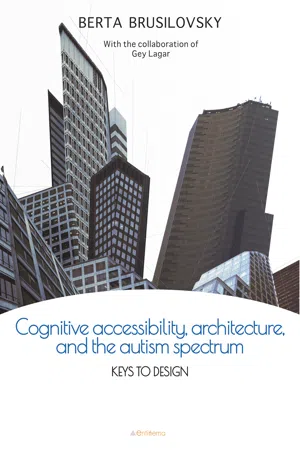
Cognitive accesibility, architecture, and the autism spectrum
Keys to design
Berta Brusilovsky
- English
- ePUB (mobile friendly)
- Available on iOS & Android
Cognitive accesibility, architecture, and the autism spectrum
Keys to design
Berta Brusilovsky
About This Book
This text deals fundamentally with design and architecture: the route of spatial recognition, which is the least known —or worked on— within the approaches of the autism spectrum given its difficulty in being synthesized in a paradigm or normative set. The objective is to create a framework to approach the design of environments and buildings, in order to facilitate spatial development in everyday life and, especially, in learning situations.The spatial route, which is the project, creates: - A set of spatial coordinates that liberates the user from the anguish of not recognizing, of not understanding the space in which he is developing. And that offer him the possibility of finding the way, directing him to where he needs or wants to go.- Structure of the exterior and interior, with their corresponding activities placed in a comprenssible way through concepts of organization: functional and sensorial sequence of events. And creation of spaces for group and individual tasks, paying special attention to places of transition and recovery between opposite or different activities, both physical and emotional.- The aspects that are developed in terms of recommendations are synthesized in a construct that brings together the aspects of general, functional, formal and sensory organization of plans, elevations and details. Achieving with these "person-space" adjustments a higher quality of personal life and of its affective and learning environment.- Design components that in the case of autism should be considered in order to seek with the project greater facility of understanding, use and space-emotional development of people from childhood to adult life.
Frequently asked questions
Information
1. INTRODUCTION
Table of contents
- COGNITIVE ACCESSIBILITY, ARCHITECTURE, AND THE AUTISM SPECTRUM
- Créditos
- Dedicatoria
- THE AUTHORS
- FOREWORD
- GETTING STARTED: A VISUAL GUIDE
- 1. INTRODUCTION
- 2. COMPONENTS FOR DESIGN
- 3. NEUROBIOLOGICAL COMPONENTS
- 4. CONDUCT AND BEHAVIOUR
- 5. GOOD DESIGN PRACTICE
- 6. DESIGN RECOMMENDATIONS
- 7. PLAYGROUNDS AND COURTYARDS
- 8. FINAL WORDS
- 9. BIBLIOGRAPHY
- 10. ANNEXES
- ACKNOWLEDGEMENTS
- Notes
- INDEX